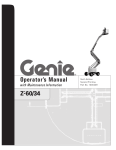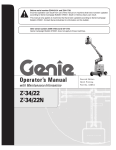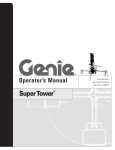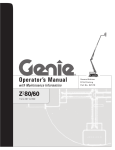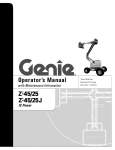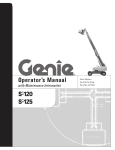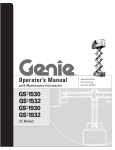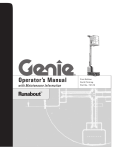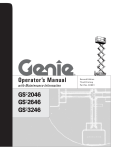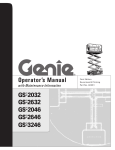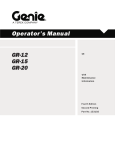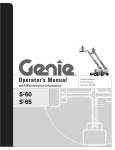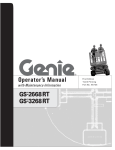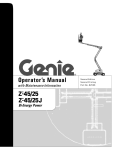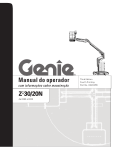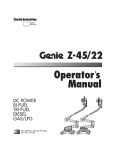Download from SN 951 to 6289, Z-30/20N (PN 43651)
Transcript
Before serial number Z30N-3448: Incorrect operation can result from use of this manual on machines that have not been updated according to Genie Campaign Bulletin 070001. Death or Serious Injury can result. This manual only applies to machines that have been updated according to Genie Campaign Bulletin 070001. Contact Genie Industries for information on this bulletin. After serial number Z30N-3447: Genie Campaign Bulletin 070001 does not apply to these machines. Operator’s Manual with Maintenance Information Second Edition Ninth Printing Part No. 43651 Operator's Manual Second Edition • Ninth Printing Important Read, understand and obey these safety rules and operating instructions before operating this machine. Only trained and authorized personnel shall be permitted to operate this machine. This manual should be considered a permanent part of your machine and should remain with the machine at all times. If you have any questions, call Genie Industries. Contents Page Safety ........................................................................ 1 Controls ..................................................................... 8 Pre-operation Inspection ........................................... 10 Maintenance ............................................................. 12 Function Tests .......................................................... 14 Workplace Inspection ............................................... 19 Operating Instructions .............................................. 20 Transport & Lifting Instructions ................................. 25 Decals ...................................................................... 28 Specifications ........................................................... 30 Copyright © 1995 by Genie Industries Contact us: First Edition: Internet:http://www.genielift.com e-mail: [email protected] Fourth Printing, August 1996 Second Edition:Ninth Printing, June 2007 "Genie"and "Z" are registered trademarks of Genie Industries in the USA and many other countries. These machines comply with ANSI/SIA 92.5-1992. Printed on recycled paper Printed in U.S.A. Genie Z-30/20N Part No. 43651 Operator's Manual Second Edition • Ninth Printing Safety Rules Danger Failure to obey the instructions and safety rules in this manual will result in death or serious injury. Do Not Operate Unless: You learn and practice the principles of safe machine operation contained in this operator's manual. 1 Avoid hazardous situations. Know and understand the safety rules before going on to the next section. 2 Always perform a pre-operation inspection. 3 Always perform function tests prior to use. 4 Inspect the workplace. 5 Only use the machine as it was intended. You read, understand and obey: Manufacturer's instructions and safety rules—safety and operator's manuals and machine decals employer's safety rules and worksite regulations applicable governmental regulations You are properly trained to safely operate the machine. Part No. 43651 Genie Z-30/20N 1 Operator's Manual Second Edition • Ninth Printing SAFETY RULES Electrocution Hazards Tip-over Hazards This machine is not electrically insulated and will not provide protection from contact with or proximity to electrical current. Occupants and equipment shall not exceed the maximum platform capacity. Maximum platform capacity 500 lbs 227 kg Maximum occupants 2 Maintain safe distances from electrical power lines and apparatus in accordance with applicable governmental regulations and the following chart. Voltage Phase to Phase Minimum Safe Approach Distance Feet Meters 0 to 300V Avoid Contact 300V to 50KV 10 3.05 50KV to 200KV 15 4.60 200KV to 350KV 20 6.10 350KV to 500KV 25 7.62 500KV to 750KV 35 10.67 750KV to 1000KV 45 13.72 Allow for platform movement, electrical line sway or sag and beware of strong or gusty winds. Do not raise or extend the boom unless the machine is on a firm, level surface. Do not depend on the tilt alarm as a level indicator. The tilt alarm sounds in the platform only when the machine is on a severe slope. If the tilt alarm sounds: Do not extend, rotate or raise the boom above horizontal. Move the machine to a firm, level surface before raising the platform. If the tilt alarm sounds when the platform is raised, use extreme caution to retract the boom and lower the platform. Do not rotate the boom while lowering. Move the machine to a firm, level surface before raising the platform. Do not alter or disable the limit switches. Keep away from the machine if it contacts energized power lines. Personnel on the ground or in the platform must not touch or operate the machine until energized power lines are shut off. Do not operate the machine during lightning or storms. Do not use the machine as a ground for welding. 2 Genie Z-30/20N Part No. 43651 Operator's Manual Second Edition • Ninth Printing SAFETY RULES Do not drive over 0.6 mph / 1 km/h with the primary boom raised or extended or the secondary boom raised. Do not use the platform controls to free a platform that is caught, snagged or otherwise prevented from normal motion by an adjacent structure. All personnel must be removed from the platform before attempting to free the platform using the ground controls. Do not operate the machine in strong or gusty winds. Do not increase the surface area of the platform or the load. Increasing the area exposed to the wind will decrease machine stability. Do not drive the machine on a slope that exceeds the maximum uphill, downhill or side slope rating of the machine. Slope rating applies to machines in the stowed position. Maximum slope rating, stowed position, Counterweight uphill 20% (11°) Counterweight downhill 20% (11°) Side slope 20% (11°) Note: Slope rating is subject to ground conditions and adequate traction. Do not push off or pull toward any object outside of the platform. Use extreme care and slow speeds while driving Maximum allowable side force - ANSI & CSA 150 lbs / 667 N Maximum allowable side force - CE 90 lbs / 400 N the machine in stowed position across uneven terrain, debris, unstable or slippery surfaces and near holes and drop-offs. Do not drive the machine on or near uneven terrain, unstable surfaces or other hazardous conditions with the boom raised or extended. Part No. 43651 Do not alter or disable machine components that in any way affect safety and stability. Do not replace items critical to machine stability with items of different weight or specification. Do not modify or alter an aerial work platform. Mounting attachments for holding tools or other materials onto the platform, toeboards or guard rail system can increase the weight in the platform and the surface area of the platform or the load. Genie Z-30/20N 3 Operator's Manual Second Edition • Ninth Printing SAFETY RULES Do not place or attach overhanging loads to any part of this machine. Fall Hazards Occupants must wear a safety belt or harness and comply with applicable governmental regulations. Attach lanyard to anchor provided in platform. Do not sit, stand or climb on the platform guard rails. Maintain a firm footing on the platform floor at all times. Do not place ladders or scaffolds in the platform or against any part of this machine. Do not use the machine on a moving or mobile surface or vehicle. Be sure all tires are in good condition and lug nuts are properly tightened. Do not use batteries that weigh less than the original equipment. Batteries are used as counterweight and are critical to machine stability. Each battery must weigh 105 pounds / 47.6 kg. Each battery box including batteries must weigh a minimum of 530 pounds / 240.4 kg. Do not use the machine as a crane. Do not climb down from the platform when raised. Keep the platform floor clear of debris. Lower the platform entry mid-rail or close the entry gate before operating. Do not push the machine or other objects with the boom. Do not contact adjacent structures with the boom. Do not tie the boom or platform to adjacent structures. Do not place loads outside the platform perimeter. 4 Genie Z-30/20N Part No. 43651 Operator's Manual Second Edition • Ninth Printing SAFETY RULES Do not lower the boom unless the area below is clear of personnel and obstructions. Collision Hazards Be aware of limited sight distance and blind spots when driving or operating. Be aware of boom position when rotating the turntable. The machine must be on a level surface or secured before releasing the brakes. Do not drive the machine with the brakes released. If the travel alarm sounds when not driving, the brakes are released. Check work area for overhead obstructions or other possible hazards. Limit travel speed according to the condition of the ground surface, congestion, slope, location of personnel, and any other factors which may cause collision. Use extreme care and slow speeds while driving the machine in the stowed position on any slope. Do not drive on a slope with boom raised. Do not allow the machine speed on any slope to exceed 3 mph / 4.8 km/h (walking pace). Stop the machine by returning the drive control handle to the center position or release the foot switch. Be aware of crushing hazards when grasping the platform guard rail. It is recommended that operators wear an approved hard hat when operating the machine. Observe and use the color-coded direction arrows on the platform controls and drive chassis for drive and steer functions. Part No. 43651 When stopped on a slope, the machine may initially move slightly downhill when the drive control handle is moved to drive up the slope. Be sure the area behind the machine is clear. Do not drive on a slope with the wheels turned. Be sure the wheels are aligned up and down the slope. Genie Z-30/20N Always use a winch to load and unload a machine from a transport vehicle. 5 Operator's Manual Second Edition • Ninth Printing SAFETY RULES Do not operate a boom in the path of any crane unless the controls of the crane have been locked out and/or precautions have been taken to prevent any potential collision. Decal Legend Genie product decals use symbols, color coding and signal words to identify the following: No stunt driving or horseplay while operating a machine. Component Damage Hazard Do not use the machine as a ground for welding. Damaged Machine Hazards Do not use a damaged or malfunctioning machine. Conduct a thorough pre-operation inspection of the machine and test all functions before each work shift. Immediately tag and remove from service a damaged or malfunctioning machine. Be sure all maintenance has been performed as specified in this manual and the Genie Z-30/20N Service Manual. Be sure all decals are in place and legible. Be sure the operator’s, safety and responsibilities manuals are complete, legible and in the storage container located on the platform. Bodily Injury Hazard Do not operate the machine with a hydraulic oil or air leak. An air leak or hydraulic leak can penetrate and/or burn skin. Safety alert symbol—used to alert personnel to potential personal injury hazards. Obey all safety messages that follow this symbol to avoid possible injury or death. Red—used to indicate the presence of an imminently hazardous situation which, if not avoided, will result in death or serious injury. Orange—used to indicate the presence of a potentially hazardous situation which, if not avoided, could result in death or serious injury. Yellow with safety alert symbol— used to indicate the presence of a potentially hazardous situation which, if not avoided, may cause minor or moderate injury. Yellow without safety alert symbol—used to indicate the presence of a potentially hazardous situation which, if not avoided, may result in property damage. Green—used to indicate operation or maintenance information. 6 Genie Z-30/20N Part No. 43651 Operator's Manual Second Edition • Ninth Printing SAFETY RULES Battery Safety Component Damage Hazards Burn Hazards Do not use any battery charger greater than 48V to charge the batteries. Batteries contain acid. Always wear protective clothing and eyewear when working with batteries. Both battery packs must be charged together. Disconnect the battery pack plug before removing the battery pack. Electrocution Hazards Connect the battery charger to a grounded, AC 3-wire electrical outlet only. Inspect daily for damaged cord, cables and wires. Replace damaged items before operating. Avoid spilling or contacting battery acid. Neutralize battery acid spills with baking soda and water. The battery pack must remain in upright position. Do not expose the batteries or the charger to water or rain. Avoid electrical shock from contact with battery terminals. Remove all rings, watches and other jewelry. Explosion Hazards Tip-over Hazard Keep sparks, flames and lighted tobacco away from batteries. Batteries emit an explosive gas. The battery pack cover must remain off during the entire charging cycle. Do not contact the battery terminals or the cable clamps with tools that may cause sparks. Part No. 43651 Do not use batteries that weigh less than the original equipment. Batteries are used as counterweight and are critical to machine stability. Each battery must weigh 105 pounds / 47.6 kg. Each battery box including batteries must weigh a minimum of 530 pounds / 240.4 kg. Lifting Hazard Use a forklift to remove or install the battery packs. Genie Z-30/20N 7 Operator's Manual Second Edition • Ninth Printing Controls Platform Control Panel 1 Drive enable switch 10 Not used 2 Drive enable indicator light 11 Proportional control handle for drive function and thumb rocker for steer function 3 Auxiliary power switch 12 Boom function speed controller 4 Platform level switch 13 Jib boom up/down switch 5 Horn button 14 Low battery indicator light 6 Boom extend/retract switch 15 Secondary boom up/down switch 7 Red Emergency Stop button 16 Primary boom up/down switch 8 Jib rotate switch (option) 9 Battery charge indicator and/or low voltage interrupt (option) 8 17 Turntable rotate switch 18 Platform rotate switch Genie Z-30/20N Part No. 43651 Operator's Manual Second Edition • Ninth Printing CONTROLS Ground Control Panel 1 2 3 4 5 6 7 Turntable rotate switch Platform rotate switch Platform level switch Boom extend/retract switch Auxiliary power switch Hour meter Key switch for platform/off/ground selection Part No. 43651 8 Red Emergency Stop button 9 10A breaker for electrical circuits 10 Remote brake release 11 Jib rotate switch (option) 12 Jib boom up/down switch 13 Secondary boom up/down switch 14 Function enable switch 15 Primary boom up/down switch Genie Z-30/20N 9 Operator's Manual Second Edition • Ninth Printing Pre-operation Inspection Fundamentals It is the responsibility of the operator to perform a pre-operation inspection and routine maintenance. Do Not Operate Unless: You learn and practice the principles of safe machine operation contained in this operator's manual. 1 Avoid hazardous situations. 2 Always perform a pre-operation inspection. The pre-operation inspection is a visual inspection performed by the operator prior to each work shift. The inspection is designed to discover if anything is apparently wrong with a machine before the operator performs the function tests. The pre-operation inspection also serves to determine if routine maintenance procedures are required. Only routine maintenance items specified in this manual may be performed by the operator. Refer to the list on the next page and check each of the items and locations for modifications, damage or loose or missing parts. Know and understand the pre-operation inspection before going on to the next section. 3 Always perform function tests prior to use. 4 Inspect the workplace. 5 Only use the machine as it was intended. A damaged or modified machine must never be used. If damage or any variation from factory delivered condition is discovered, the machine must be tagged and removed from service. Repairs to the machine may only be made by a qualified service technician, according to the manufacturer's specifications. After repairs are completed, the operator must perform a pre-operation inspection again before going on to the function tests. Scheduled maintenance inspections shall be performed by qualified service technicians, according to the manufacturer's specifications and the requirements listed in the responsibilities manual. 10 Genie Z-30/20N Part No. 43651 Operator's Manual Second Edition • Ninth Printing PRE-OPERATION INSPECTION Pre-operation Inspection ! Be sure that the operator's, safety and responsibilities manuals are complete, legible and in the storage container located on the platform. ! Be sure that all decals are legible and in place. See Decals section. ! Check for hydraulic oil leaks and proper oil level. Add oil if needed. See Maintenance section. ! Check for battery fluid leaks and proper fluid level. Add distilled water if needed. See Maintenance section. Check the following components or areas for damage, modifications and improperly installed or missing parts: Check entire machine for: ! Cracks in welds or structural components ! Dents or damage to machine ! Be sure that all structural and other critical components are present and all associated fasteners and pins are in place and properly tightened. ! Be sure that both battery packs are in place, latched and properly connected. ! After you complete your inspection, be sure that all compartment covers are in place and latched. ! Electrical components, wiring and electrical cables ! Hydraulic power unit, reservoir, hoses, fittings, cylinders and manifolds ! Drive and turntable motors and torque hubs ! Boom wear pads ! Tires and wheels ! Limit switches, alarms and horn ! Nuts, bolts and other fasteners ! Platform entry mid-rail/gate ! Beacon and alarms (if equipped) Part No. 43651 Genie Z-30/20N 11 Operator's Manual Second Edition • Ninth Printing Maintenance Check the Hydraulic Oil Level Observe and Obey: Only routine maintenance items specified in this manual shall be performed by the operator. Scheduled maintenance inspections shall be completed by qualified service technicians, according to the manufacturer's specifications and the requirements specified in the responsibilities manual. Maintaining the hydraulic oil at the proper level is essential to machine operation. Improper hydraulic oil levels can damage hydraulic components. Daily checks allow the inspector to identify changes in oil level that might indicate the presence of hydraulic system problems. 1 Be sure that the boom is in the stowed position. 2 Visually inspect the reservoir on the hydraulic power unit. Result: The hydraulic oil level should be within the FULL and ADD marks on the hydraulic reservoir. Hydraulic oil specifications Maintenance Symbols Legend The following symbols have been used in this manual to help communicate the intent of the instructions. When one or more of the symbols appear at the beginning of a maintenance procedure, it conveys the meaning below. Hydraulic oil type Refer to machine decal Indicates that tools will be required to perform this procedure. Indicates that new parts will be required to perform this procedure. 12 Genie Z-30/20N Part No. 43651 Operator's Manual Second Edition • Ninth Printing MAINTENANCE Check the Batteries Scheduled Maintenance Proper battery condition is essential to good engine performance and operational safety. Improper fluid levels or damaged cables and connections can result in engine component damage and hazardous conditions. Electrocution hazard. Contact with hot or live circuits could result in death or serious injury. Remove all rings, watches and other jewelry. Maintenance performed quarterly, annually and every two years must be completed by a person trained and qualified to perform maintenance on this machine according to the procedures found in the service manual for this machine. Machines that have been out of service for more than three months must receive the quarterly inspection before they are put back into service. Bodily injury hazard. Batteries contain acid. Avoid spilling or contacting battery acid. Neutralize battery acid spills with baking soda and water. Perform this test after fully charging the batteries. 1 Put on protective clothing and eye wear. 2 Be sure that the battery cable connections are tight and free of corrosion. 3 Remove the battery vent caps. 4 Check the battery acid level. If necessary, replenish with distilled water to the bottom of the battery fill tube. Do not overfill. 5 Install the vent caps. Part No. 43651 Genie Z-30/20N 13 Operator's Manual Second Edition • Ninth Printing Function Tests Fundamentals The function tests are designed to discover any malfunctions before the machine is put into service. The operator must follow the step-by-step instructions to test all machine functions. Do Not Operate Unless: You learn and practice the principles of safe machine operation contained in this operator's manual. 1 Avoid hazardous situations. A malfunctioning machine must never be used. If malfunctions are discovered, the machine must be tagged and removed from service. Repairs to the machine may only be made by a qualified service technician, according to the manufacturer’s specifications. After repairs are completed, the operator must preform a pre-operation inspection and function tests again before putting the machine into service. 2 Always perform a pre-operation inspection. 3 Always perform function tests prior to use. Know and understand the function tests before going on to the next section. 1 Select a test area that is firm, level and free of obstruction. 4 Inspect the workplace. 5 Only use the machine as it was intended. At the Ground Controls 2 Turn the key switch to ground control. 3 Pull out the red Emergency Stop button to the on position. Result: The beacon (if equipped) should flash. Test Emergency Stop 4 Push in the red Emergency Stop button to the off position. Result: All ground and platform control functions should not operate. 5 Pull out the red Emergency Stop button to the on position. 14 Genie Z-30/20N Part No. 43651 Operator's Manual Second Edition • Ninth Printing FUNCTION TESTS Test the Boom Functions Test Auxiliary Controls 6 Do not hold the function enable switch to either side. Attempt to activate each boom and platform function toggle switch. 11 Turn the key switch to ground control. Result: All boom and platform functions should not operate. 7 Hold the function enable switch to either side and activate each boom and platform function toggle switch. Result: All boom and platform functions should operate through a full cycle. The descent alarm (if equipped) should sound while the boom is lowering. Machines equipped with Platform Level Control Disable Function: The platform level toggle switch will not operate when the primary boom is raised past the drive speed limit switch. Test the Tilt Sensor 8 Pull out the platform red Emergency Stop button to the on position. Turn the key switch to platform control. 12 Simultaneously hold the auxiliary power switch on and activate each boom function toggle switch. Note: To conserve battery power, test each function through a partial cycle. Result: All boom functions should operate. 13 Turn the key switch to platform control. At the Platform Controls Test Emergency Stop 14 Push in the platform red Emergency Stop button to the off position. Result: All platform control functions should not operate. Test the Horn 15 Pull out the red Emergency Stop button to the on position. 9 Open the ground control side turntable cover and locate the tilt sensor next to the function manifold. 16 Push the horn button. 10 Press down one side of the tilt sensor. Test the Foot Switch Result: The alarm, located in the platform, should sound. Result: The horn should sound. 17 Do not press down the foot switch. Activate each machine function. Result: The machine functions should not operate. Part No. 43651 Genie Z-30/20N 15 Operator's Manual Second Edition • Ninth Printing FUNCTION TESTS Test Machine Functions Test Drive and Braking 18 Move the lift/drive select switch to the lift position (if equipped). 25 Move the lift/drive select switch to the drive position (if equipped). 19 Press down the foot switch. 26 Press down the foot switch. 20 Activate each machine function toggle switch. 27 Slowly move the drive control handle in the direction indicated by the blue arrow on the control panel until the machine begins to move, then return the handle to the center position. Result: All boom/platform functions should operate through a full cycle. Note: Control the speed of boom functions by adjusting the boom function speed controller. Drive and steer functions are not affected by the boom function speed controller. Machines equipped with Platform Level Control Disable Function: The platform level toggle switch will not operate when the primary boom is raised past the drive speed limit switch. Test the Steering 21 Move the lift/drive select switch to the drive position (if equipped). 22 Press down the foot switch. 28 Slowly move the drive control handle in the direction indicated by the yellow arrow on the control panel until the machine begins to move, then return the handle to the center position. Result: The travel alarm should sound. The machine should move in the direction that the yellow arrow points on the drive chassis, then come to an abrupt stop. Test Limited Drive Speed 23 Depress the thumb rocker switch on top of the drive control handle in the direction identified by the blue triangle on the control panel. Result: The steer wheels should turn in the direction that the blue triangles point on the drive chassis. 24 Depress the thumb rocker switch in the direction identified by the yellow triangle on the control panel. Result: The steer wheels should turn in the direction that the yellow triangles point on the drive chassis. 16 Result: The travel alarm should sound. The machine should move in the direction that the blue arrow points on the drive chassis, then come to an abrupt stop. 29 Move the lift/drive select switch to the lift position (if equipped). 30 Press down the foot switch. 31 Raise the primary boom 1 foot / 30 cm. 32 Move the lift/drive select switch to the drive position (if equipped). 33 Slowly move the drive control handle to the full drive position. Result: The maximum achievable drive speed with the primary boom raised should not exceed 1 foot / 30 cm per second. Genie Z-30/20N Part No. 43651 Operator's Manual Second Edition • Ninth Printing FUNCTION TESTS 34 Move the lift/drive select switch to the lift position (if equipped). Test the Drive Enable System 44 Move the lift/drive select switch to the lift position (if equipped). 35 Lower the boom to the stowed position. 36 Raise the secondary boom 1 foot / 30 cm. 37 Move the lift/drive select switch to the drive position (if equipped). 38 Slowly move the drive control handle to the full drive position. Result: The maximum achievable drive speed with the secondary boom raised should not exceed 1 foot / 30 cm per second. 39 Move the lift/drive select switch to the lift position (if equipped). 45 Press down the foot switch and retract the primary boom to the stowed position. 46 Rotate the turntable until the boom moves past one of the non-steer wheels. Result: The drive enable indicator light should come on and remain on while the boom is anywhere in the range shown. 47 Move the drive control handle off center. 40 Lower the boom to the stowed position. Result: The drive function should not operate. 41 Extend the primary boom 1 foot / 30 cm. 42 Move the lift/drive select switch to the drive position (if equipped). 43 Slowly move the drive control handle to the full drive position. Result: The maximum achievable drive speed with the primary boom extended should not exceed 1 foot / 30 cm per second. If the drive speed with the primary boom raised or extended or the secondary boom raised exceeds 1 foot / 30 cm per second, immediately tag and remove the machine from service. 48 Hold the drive enable toggle switch up or down and slowly move the drive control handle off center. Result: The drive function should operate. Blue Note: When the drive enable system is in use, the machine may drive in the opposite direction that the drive and steer control handle is moved. Use the color-coded direction arrows on the platform controls and the drive chassis to identify the direction of travel. Yellow Part No. 43651 Genie Z-30/20N 17 Operator's Manual Second Edition • Ninth Printing FUNCTION TESTS Test Auxiliary Controls Test the Lift/Drive Select Function (CE models) 49 Move the lift/drive select switch to the appropriate position (if equipped). Machines with lift/drive select switch: 50 Press down the foot switch. 51 Simultaneously hold the auxiliary power switch on and activate each function control handle or toggle switch. Note: To conserve battery power, test each function through a partial cycle. Result: All boom, steer and drive functions should operate. 52 Move the lift/drive select switch to the lift position. 53 Press down the foot switch. 54 Move the drive control handle off center. Result: No drive functions should operate. 55 Activate each boom function toggle switch. Result: All boom functions should operate. 56 Move the lift/drive select switch to the drive position. 57 Press down the foot switch. 58 Activate each boom function toggle switch. Result: No boom functions should operate. 59 Move the drive control handle off center. Result: The drive functions should operate. Machines without lift/drive select switch: 60 Press down the foot switch. 61 Move the drive control handle off center and activate a boom function toggle switch. Result: No boom functions should operate. The machine will move in the direction indicated on the control panel. 18 Genie Z-30/20N Part No. 43651 Operator's Manual Second Edition • Ninth Printing Workplace Inspection Workplace Inspection Be aware of and avoid the following hazardous situations: Do Not Operate Unless: You learn and practice the principles of safe machine operation contained in this operator's manual. · drop-offs or holes · bumps, floor obstructions or debris · overhead obstructions and high voltage conductors · hazardous locations · inadequate surface support to withstand all load forces imposed by the machine · wind and weather conditions · the presence of unauthorized personnel · other possible unsafe conditions · Determine the slope of any surface in the path of travel on the job site 1 Avoid hazardous situations. 2 Always perform a pre-operation inspection. 3 Always perform function tests prior to use. 4 Inspect the workplace. Know and understand the workplace inspection before going on to the next section. 5 Only use the machine as it was intended. Fundamentals The workplace inspection helps the operator determine if the work place is suitable for safe machine operation. It should be performed by the operator prior to moving the machine to the workplace. It is the operator's responsibility to read and remember the workplace hazards, then watch for and avoid them while moving, setting up and operating the machine. Part No. 43651 Genie Z-30/20N 19 Operator's Manual Second Edition • Ninth Printing Operating Instructions Fundamentals The Operating Instructions section provides instructions for each aspect of machine operation. It is the operator's responsibility to follow all the safety rules and instructions in the operator's, safety and responsibilities manuals. Do Not Operate Unless: You learn and practice the principles of safe machine operation contained in this operator's manual. 1 Avoid hazardous situations. 2 Always perform a pre-operation inspection. 3 Always perform function tests prior to use. 4 Inspect the workplace. 5 Only use the machine as it was intended. 20 Using the machine for anything other than lifting personnel and tools to an aerial work site is unsafe and dangerous. Only trained and authorized personnel should be permitted to operate a machine. If more than one operator is expected to use a machine at different times in the same work shift, they must all be qualified operators and are all expected to follow all safety rules and instructions in the operator's, safety and responsibilities manuals. That means every new operator should perform a pre-operation inspection, function tests, and a workplace inspection before using the machine. Genie Z-30/20N Part No. 43651 Operator's Manual Second Edition • Ninth Printing OPERATING INSTRUCTIONS Emergency Stop Operation from Ground Push in the red Emergency Stop button to the off position at the ground or platform controls to stop all machine functions. 1 Turn the key switch to ground control. Repair any function that operates when the red Emergency Stop button is pushed in. Selecting and operating the ground controls will override the platform red Emergency Stop button. 2 Pull out the red Emergency Stop button to the on position. 3 Be sure both battery packs are connected before operating the machine. To Position Platform 1 Hold the function enable switch to either side. Auxiliary Controls Use auxiliary power if the primary power source fails. 1 Turn the key switch to ground or platform control. 2 Pull out the red Emergency Stop button to the on position. 3 Move the lift/drive select switch to the appropriate position (if equipped) when operating the auxiliary controls from the platform. 2 Move the appropriate toggle switch according to markings on the control panel. Drive and steer functions are not available from the ground controls. Machines equipped with Platform Level Control Disable Function: The platform level toggle switch will not operate when the boom is raised past the drive speed limit switch. 4 Press down the foot switch when operating the auxiliary controls from the platform. 5 Simultaneously hold the auxiliary power switch on and activate the desired function. The boom, steer and drive functions will operate with auxiliary power. Part No. 43651 Genie Z-30/20N 21 Operator's Manual Second Edition • Ninth Printing OPERATING INSTRUCTIONS Operation from Platform To Drive 1 Turn the key switch to platform control. 1 Press down the foot switch. 2 Pull out both ground and platform red Emergency Stop buttons to the on position. 2 Increase speed: Slowly move the drive control handle off center. 3 Be sure that both battery packs are connected before operating the machine. Decrease speed: Slowly move the drive control handle toward center. To Position Platform Stop: Return the drive control handle to center or release the foot switch. 1 Move the lift/drive select switch to the lift position (if equipped). 2 Set the boom function speed controller to the desired speed. Note: Drive and steer functions are not affected by the boom function speed controller. 3 Press down the foot switch. 4 Move the appropriate toggle switch according to the markings on the control panel. Machines equipped with Platform Level Control Disable Function: The platform level toggle switch will not operate when the boom is raised past the drive speed limit switch. To Steer Use the color-coded direction arrows on the platform controls and the drive chassis to identify the direction the machine will travel. The travel alarm will sound when the drive controller is moved off center. Note: When the turntable is rotated so the boom is past the non-steer tires, the machine may move in the opposite direction that the drive and steer controls are moved. Machine travel speed is restricted when the booms are raised or extended. Battery condition will affect the ability of the machine to climb a slope. 1 Press down the foot switch. 2 Turn the steer wheels with the thumb rocker switch located on top of the drive control handle. Use the color-coded direction arrows on the platform controls and the drive chassis to identify the direction the wheels will turn. 22 Genie Z-30/20N Part No. 43651 Operator's Manual Second Edition • Ninth Printing OPERATING INSTRUCTIONS Driving on a slope Determine the uphill, downhill and side slope ratings for the machine and determine the slope grade. Maximum slope rating, counterweight uphill (gradeability): 20% (11°) While holding the piece of wood level, measure the vertical distance from the bottom of the piece of wood to the ground. Divide the tape measure distance (rise) by the length of the piece of wood (run) and multiply by 100. Example: Maximum slope rating, counterweight downhill: 20% (11°) run Maximum side slope rating: 20% (11°) rise Note: Slope rating is subject to ground conditions and adequate traction. The term gradeability applies to the counterweight uphill configuration only. Piece of wood = 144 inches (3.6 m) Run = 144 inches (3.6 m) Be sure the boom is below horizontal and the platform is between the non-steer tires. Rise = 12 inches (0.3 m) To determine the slope grade: 12 in ÷ 144 in = 0.083 x 100 = 8.3% grade Measure the slope with a digital inclinometer OR use the following procedure. 0.3 m ÷ 3.6 m = 0.083 x 100 = 8.3 % grade You will need: carpenter’s level If the slope exceeds the maximum uphill, downhill or side slope rating, then the machine must be winched or transported up or down the slope. See Transport and Lifting Instructions section. straight piece of wood, at least 3 feet / 1 m long tape measure Lay the piece of wood on the slope. At the downhill end, lay the level on the top edge of the piece of wood and lift the end until the piece of wood is level. Part No. 43651 Genie Z-30/20N 23 Operator's Manual Second Edition • Ninth Printing OPERATING INSTRUCTIONS Driving Up/Down Slopes Driving down a slope Drive/Brake Control Theory Be sure the platform is fully lowered and the platform is between the drive wheels. Be sure the wheels are aligned up and down the slope. Brakes release progressively as the drive control handle is moved out of neutral in either direction. Brakes apply progressively as the drive control handle is moved toward the neutral position. If the machine is on a slope, the progressive release/ application of the brakes combined with torque from the drive motors allows you to control the speed of the machine. For this reason, in some circumstances it is more effective to drive down a sloped surface by moving the drive control handle in the uphill direction. This is called “plug braking.” Apply these principles for driving on a slope by following the instructions below. Driving up a slope Be sure the platform is fully lowered and the platform is between the drive wheels. Be sure the wheels are aligned up and down the slope. 1 Press down the foot switch. 2 Move the drive control handle firmly. When stopped on a slope, the machine may initially move slightly downhill when the drive control handle is moved to drive up the slope. Be sure the area behind the machine is clear. 1 Position the steer wheels on the downhill side of the slope. 2 Press down the foot switch. 3 On steeper slopes, it may be more effective to move the drive control handle in the uphill direction (plug braking) in order to drive downhill. For this reason, no matter what slope you are on, always begin the process of driving downhill by slowly moving the drive control handle in the uphill direction. Use small movements of the drive control handle to control the machine speed. If the machine moves uphill instead of downhill, the slope is too small to use plug braking. Move the drive control handle back to the neutral position to apply the brakes and proceed as follows: 4 Slowly move the drive control handle downhill. Use small movements of the drive control handle to control the machine speed. To stop the machine completely, return the drive control handle to the center (neutral position). The machine can also be stopped by removing your foot from the foot switch or pushing in the red Emergency Stop button. If machine speed exceeds 3 mph / 4.8 km/h (walking pace), immediately stop the machine. 24 Genie Z-30/20N Part No. 43651 Operator's Manual Second Edition • Ninth Printing OPERATING INSTRUCTIONS Drive Enable After Each Use Light on indicates that the boom has moved past either non-steer wheel and the drive function has been interrupted. 1 Select a safe parking location—firm level surface, clear of obstruction and traffic. To drive, hold the drive enable switch up or down and slowly move the drive control handle off center. Be aware that the machine may move in the opposite direction that the drive and steer controls are moved. Always use the color-coded direction arrows on the platform controls and the drive chassis to identify the direction the machine will travel. 2 Lower the boom to the stowed position. 3 Rotate the turntable so that the boom is between the non-steer wheels. 4 Turn the key switch to the off position and remove the key to secure from unauthorized use. 5 Chock the wheels. 6 Charge the batteries. Low Battery Indicator Light Flashing light indicates battery power is low and the batteries need to be charged. There is adequate power left to lower the boom and move it to a location where the batteries can be charged. Light on indicates the batteries are fully discharged. Stop using the boom and charge the batteries immediately. Note: Machines equipped with Low Voltage Interrupt Option will lose primary and secondary boom lift functions when batteries are fully discharged. Part No. 43651 Genie Z-30/20N 25 Operator's Manual Second Edition • Ninth Printing OPERATING INSTRUCTIONS Dry Battery Filling and Charging Instructions 1 Remove the battery vent caps and permanently remove the plastic seal from the battery vent openings. Battery and Charger Instructions 2 Fill each cell with battery acid (electrolyte) until the level is sufficient to cover the plates. Observe and Obey: Do not fill to maximum level until the battery charge cycle is complete. Overfilling can cause the battery acid to overflow during charging. Neutralize battery acid spills with baking soda and water. Do not use an external charger or booster battery. Charge the battery in a well-ventilated area. 3 Install the battery vent caps. Use proper AC input voltage for charging as indicated on the charger. 4 Charge the battery. Use only a Genie authorized battery and charger. 5 Check the battery acid level when the charging cycle is complete. Replenish with distilled water to the bottom of the fill tube. Do not overfill. To Charge Battery 1 Be sure the batteries are connected before charging the batteries. 2 Open the battery compartment. The compartment should remain open for the entire charging cycle. 3 Remove the battery vent caps and check the battery acid level. If necessary, add only enough distilled water to cover the plates. Do not overfill prior to the charge cycle. 4 Replace the battery vent caps. 5 Connect the battery charger to a grounded AC circuit. 6 Turn the battery charger on. 7 The charger will indicate when the battery is fully charged. 8 Check the battery acid level when the charging cycle is complete. Replenish with distilled water to the bottom of the fill tube. Do not overfill. 26 Genie Z-30/20N Part No. 43651 Operator's Manual Second Edition • Ninth Printing Transport & Lifting Instructions Free-wheel Configuration for Winching 1 Chock the wheels to prevent the machine from rolling. Observe and Obey: The transport vehicle must be parked on a level surface. 2 Release the non-steer wheel brakes by turning over the torque hub disconnect caps (see below). The transport vehicle must be secured to prevent rolling while the machine is being loaded. Machines with remote brake switch: Plug the switch into the adaptor at the ground control box. Apply the remote brake release switch while winching the machine. Be sure the vehicle capacity, loading surfaces and chains or straps are sufficient to withstand the machine weight. See serial plate. 3 Be sure the winch line is properly secured to the drive chassis tie points and the path is clear of all obstructions. The machine must be on a level surface or secured before releasing the brakes. Always use a winch to load and unload a machine from a transport vehicle. After the machine is loaded: 1 Chock the wheels to prevent the machine from rolling. 2 Apply the non-steer wheel brakes by turning over the torque hub disconnect caps (see below). Towing the Genie Z-30/20N is not recommended. If the machine must be towed, do not exceed 2 mph / 3.2 km/h. Disengage Position Engage Position Remote brake switch Part No. 43651 Genie Z-30/20N 27 Operator's Manual Second Edition • Ninth Printing TRANSPORT & LIFTING INSTRUCTIONS Securing to Truck or Trailer for Transit Always chock the machine wheels in preparation for transport. Turn the key switch to the off position and remove the key before transporting. Inspect the entire machine for loose or unsecured items. Securing the Platform Make sure the jib and platform are in the stowed position. Place a block under the edge of the platform beneath the platform entry. Secure the platform with a nylon strap placed over the platform mount near the platform rotator (see below). Do not use excessive downward force when securing the boom section. Securing the Chassis Use the tie points on the drive chassis for anchoring down to the transport surface. Use chains or straps of ample load capacity. Use a minimum of 4 chains. Adjust the rigging to prevent damage to the chains. 28 Genie Z-30/20N Part No. 43651 Operator's Manual Second Edition • Ninth Printing TRANSPORT & LIFTING INSTRUCTIONS Lifting Instructions Fully lower and retract the boom. Fully lower the jib. Remove all loose items on the machine. Determine the center of gravity of your machine using the table and the picture on this page. Observe and Obey: Attach the rigging only to the designated lifting points on the machine. There are four lifting points on the chassis. Only qualified riggers should rig and lift the machine. Be sure the crane capacity, loading surfaces and straps or lines are sufficient to withstand the machine weight. See serial plate. Part No. 43651 Adjust the rigging to prevent damage to the machine and to keep the machine level. X Axis 31.2 in 79.2 cm Y Axis 34.3 in 87.2 cm Genie Z-30/20N 29 Operator's Manual Second Edition • Ninth Printing Decals Decal Inspection Use the pictures on the next page to verify that all decals are legible and in place. Below is a numerical list with quantities and descriptions. Part No. Decal Description 27564 Danger - Electrocution Hazard 28157 Part No. Decal Description 2 37053 Arrow - Blue 1 Label - Dexron 1 37054 Arrow - Yellow 1 28161 Danger - Crushing Hazard 3 37055 Triangle- Blue 2 28164 Notice - Hazardous Materials 1 37056 Triangle - Yellow 2 28165 Notice - Foot Switch 1 38110 Label - Travel Alarm 1 28171 Label - No Smoking 2 38111 Warning - Brakes Release 1 28174 Power to Platform, 230V 2 38112 Caution - Collision Hazard 1 28175 Caution - Compartment Access 1 40434 Label - Lanyard Anchorage 2 28176 Notice - Missing Manuals 1 43036 Platform Control Panel 1 28177 Warning - Platform Rotate 2 43652 Ground Control Panel 1 28181 Warning - No Step or Ride 1 43653 Notice - Operating Instructions, Ground 1 28235 Power to Platform, 115V 2 43658 Power to Charger, 230V 1 28236 Warning - Failure To Read . . . 1 43663 Notice - Function Enable 1 28372 Caution - Component Damage 2 44980 Power to Charger, 115V 1 31060 Danger - Tip-over Hazard, Interlock 4 44981 Airline to Platform 2 31508 Notice - Power to Charger 1 44986 Notice - Max Manual Force, 90 lbs / 400 N 1 31785 Notice - Battery Charger Instructions 2 52968 Cosmetic - Genie Boom 1 31786 Notice - Battery Connection Diagram 2 62928 Cosmetic - Genie Z-30/20N 1 31787 Danger - Tip-over, Batteries 2 62929 Cosmetic - Genie Z-30/20N 2 31788 Danger - Battery/Charger Safety 2 65171 Label - Circuit Breaker & Status Light 1 32700 Danger - Safety Rules 1 72080 Ground Control Panel 1 33952 Danger - Tilt-Alarm 1 72081 Platform Control Panel 1 35542 Notice - Lug Nuts 4 72167 Cosmetic - Genie Z-30/20N RJ 1 35583 Platform Control Panel 1 72833 Label - Open 2 37051 Notice - Max Side Force, 150 lbs / 667 N 1 82336 Label - Chevron Rykon 1 37052 Notice - Maximum Load, 500 lbs / 227 kg 1 114330 Danger - Safety Rules 1 114333 Notice - Operating Instructions, Platform 1 30 Quantity Genie Z-30/20N Quantity Part No. 43651 Operator's Manual Second Edition • Ninth Printing DECALS Ground Controls Side Chassis Platform Power Unit Side Shading indicates decal is hidden from view, i.e., under covers. Part No. 43651 Genie Z-30/20N 31 Operator's Manual Second Edition • Ninth Printing Specifications Height, working maximum Models without rotating jib 36 ft 11 m Height, working maximum Models with rotating jib 35 ft 2 in 10.7 m Height, platform maximum Models without rotating jib 30 ft Height, platform maximum Models with rotating jib Maximum slope rating, stowed position, Counterweight uphill 20% (11°) Counterweight downhill 20% (11°) 9.1 m Side slope 20% (11°) 29 ft 2 in 8.8 m Note: Slope rating is subject to ground conditions and adequate traction. 6 ft 7 in 2m 21 ft 6.4 m Width 3 ft 11 in 1.2 m Length, stowed Models without rotating jib 16 ft 9 in 5.1 m Length, stowed Models with rotating jib 17 ft 6 in 5.3 m Height, stowed maximum Horizontal reach maximum Maximum load capacity 46 inch / 117 cm platform 227 kg 5 ft 2 in 1.6 m Turning radius (outside) 9 ft 10 in 3.0 m Turning radius (inside) 5 ft 5 in 1.7 m Turntable rotation Turntable tailswing Power source Controls Platform dimensions, (length x width) 359° 4 gallons 15 liters Weight See Serial Plate (Machine weights vary with option configurations) Airborne noise emissions 70 dB Maximum sound level at normal operating workstations (A-weighted) Drive speed, stowed 0 - 3.3 mph 40 ft/8.2 sec 0 - 5.3 km/h 12.2 m/8.2 sec Drive speed, booms raised or extended 0 - 0.6 mph 40 ft/40 sec 0 - 1.0 km/h 12.2 m/40 sec Continuous improvement of our products is a Genie policy. Product specifications are subject to change without notice or obligation. 8 Group-L16, 6V 350AH Batteries 24V DC proportional 46 in x 30 in 1.17 m x 76 cm self-leveling Platform rotation 180° Jib rotation (optional) 200° AC outlet in platform standard Hydraulic pressure, maximum (boom functions) 2800 psi 193 bar 32 8.9 cm 0° Platform leveling Tire size (solid rubber) Hydraulic tank capacity 31/2 in Drive speeds 500 lb Wheelbase Ground clearance 22 x 7 x 173/4 in 56 x 18 x 45 cm Genie Z-30/20N Part No. 43651 Operator's Manual Second Edition • Ninth Printing Part No. 43651 Genie Z-30/20N 33 Genie North America Phone 425.881.1800 Toll Free USA and Canada 800.536.1800 Fax 425.883.3475 Genie Australia Pty Ltd. Phone +61 7 3375 1660 Fax +61 7 3375 1002 Genie Scandinavia Phone +46 31 575100 Fax +46 31 579020 Genie France Phone +33 (0)2 37 26 09 99 Fax +33 (0)2 37 26 09 98 Genie Iberica Phone +34 93 579 5042 Fax +34 93 579 5059 Genie Germany Phone +49 (0)4202 88520 Fax +49 (0)4202 8852-20 Genie U.K. Phone +44 (0)1476 584333 Fax +44 (0)1476 584334 Genie Mexico City Phone +52 55 5666 5242 Fax +52 55 5666 3241 Genie China Phone +86 21 53852570 Fax +86 21 53852569 Genie Malaysia Phone +65 98 480 775 Fax +65 67 533 544 Genie Japan Phone +81 3 3453 6082 Fax +81 3 3453 6083 Genie Korea Phone +82 25 587 267 Fax +82 25 583 910 Genie Brasil Phone +55 11 41 665 755 Fax +55 11 41 665 754 Genie Holland Phone +31 183 581 102 Fax +31 183 581 566




































